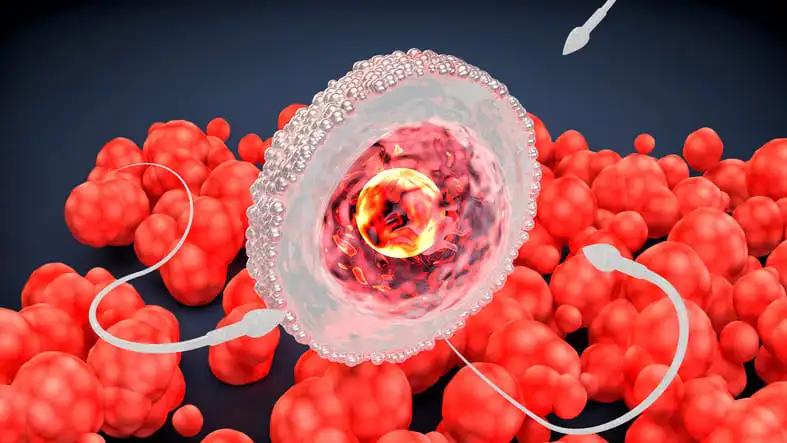KEY TAKEAWAYS
- The open-label Phase Ib/II study assessed the combination of Glofit + Pola in treating R/R DLBCL to determine the recommended Phase II dose of Glofit combined with Pola.
- Additional objectives included assessing safety, efficacy, pharmacokinetics (PK), and exploratory biomarkers.
- The study showed promising results for combining Glofit + Pola in treating R/R DLBCL with manageable safety and encouraging efficacy.
This open-label, multicenter Phase Ib/II clinical trial evaluated the combination therapy of glofitamab (Glofit) and polatuzumab vedotin (Pola) for treating relapsed/refractory diffuse large B-cell lymphoma (R/R DLBCL).
Patients (pts) were administered obinutuzumab at a dose of 1000 mg on the first day (D1) of the initial 21-day cycle (C) as a precautionary measure to reduce the risk of cytokine release syndrome (CRS). Pola was given at a dosage of 1.8 mg/kg on C1D2 and D1 of C2 through C6. Glofit was administered with a step-up dosing approach during the first cycle (C1), including doses of 2.5 mg on C1D8, 10 mg on C1D15, and 10/30 mg on the first day of cycles C2 through C12. According to the study protocol, hospitalization for 24 hours was mandatory only after the initial Glofit infusion.
The primary objective of this study was to determine the recommended Phase II dose of Glofit when combined with Pola, which was identified as 30 mg based on the findings presented by Hutchings et al. at ASH in 2021. Additional objectives included assessing safety, efficacy, pharmacokinetics (secondary), and exploring potential biomarkers.
As of January 25, 2023,111 pts administered at least one dose of the study drug. The median age of these pts was 68 years (range 23 to 82). 51.5% were diagnosed with R/R DLBCL, 24% had R/R HGBCL, 23% had R/R trFL, and 2% had R/R PMBCL. 71% of the pts had experienced refractoriness to their most recent treatment. The median of previous lines of treatment was 2, ranging from 1 to 7; 39% of pts had received only one prior line of treatment, and 25% of the pts had a history of prior chimeric antigen receptor (CAR) T-cell therapy. The most frequently observed AE was CRS, which occurred in 44% of pts.
Most CRS cases were categorized as ASTCT criteria Grade 1 or 2, with 30% classified as Grade 1 and 14% as Grade 2. One patient experienced Grade 5 CRS in the context of urosepsis and herpetic stomatitis but opted not to undergo intensive CRS management. Grade 3/4 AEs were reported in 61% of pts, with the most common being neutropenia, affecting 30% of pts; one event of febrile neutropenia was recorded. Additionally, three patients exhibited neurologic AEs related to Glofit, potentially consistent with immune effector cell-associated neurotoxicity syndrome (ICANS) and graded as either Grade 1 or Grade 2.
Pola-related peripheral neuropathy was registered in 21% of pts, and all cases were classified as Grade 1 or Grade 2. Serious adverse events (SAEs) were experienced by 59% of pts, and Grade 5 adverse events (AEs) were reported in 6% of pts, with five out of seven Grade 5 events attributed to COVID-19.9% of pts discontinuing their treatment due to an AE, with 2% discontinuing specifically because of COVID-19. Among the 109 pts whose efficacy could be assessed, the best overall response rate (BORR) for both dosing cohorts, as per Lugano 2014 criteria, was 78%. The best complete response rate (BCR) was 56%.
When analyzed by histological subtypes, the BORR and BCR were as follows: for R/R DLBCL, 86% (48 out of 56) and 61% (34 out of 56); for R/R trFL, 77% (20 out of 26) and 54% (14 out of 26); for R/R PMBCL, 100% (2 out of 2) and 100% (2 out of 2); and HGBCL, 60% (15 out of 25) and 44% (11 out of 25). With a median follow-up (FU) duration of 13.0 mos (95% confidence interval: 11.8–16.6), the median progression-free survival (PFS) was 10.4 mos (95% CI: 5.8–19.0), the median duration of response (DoR) was stated as 17.9 mos (95% CI: 10.1–not estimable).
The combination therapy of Glofit and Pola demonstrated frequent and long-lasting responses while maintaining a manageable safety profile. The incidence of CRS mainly was of low grade, and the prevalence of ICANS was low. The safety profile observed was in line with the safety profiles of the individual drugs. Updated data regarding efficacy, pharmacokinetics (PK), and biomarkers will be presented.
Source: https://onlinelibrary.wiley.com/doi/10.1002/hon.3163_92
Clinical Trial: https://classic.clinicaltrials.gov/ct2/show/NCT03533283
Hutchings, M., Avigdor, A., Sureda, A., Terol, M. J., Bosch, F., Corradini, P., Stauffer Larsen, T., Rueda Domínguez, A., Skarbnik, A., Jørgensen, J., Goldschmidt, N., Gurion, R., Zinzani, P. L., Pinto, A., Cordoba, R., Bottos, A., Huang, Z., Simko, S., Relf, J., Filézac de L’Etang, A., Sellam, G., Gritti, G. GLOFITAMAB PLUS POLATUZUMAB VEDOTIN DEMONSTRATES DURABLE RESPONSES AND A MANAGEABLE SAFETY PROFILE IN PATIENTS WITH RELAPSED/REFRACTORY DIFFUSE LARGE B-CELL LYMPHOMA https://onlinelibrary.wiley.com/doi/10.1002/hon.3163_92



